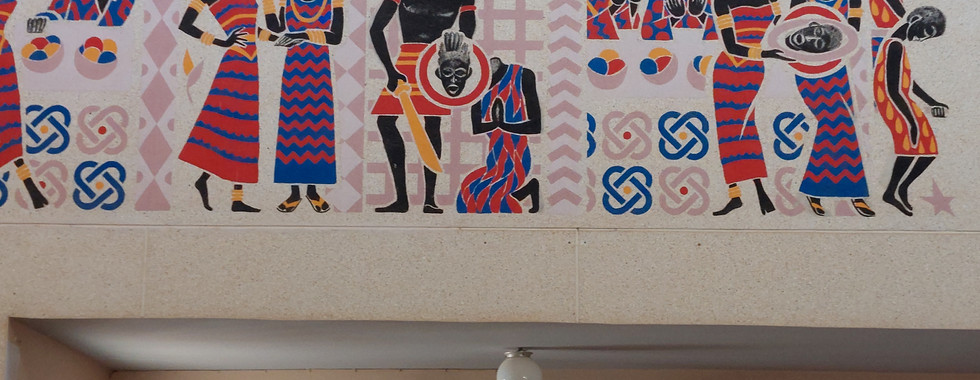
Over the last months, unexpected events and other peoples’ agendas have led me to focus anew on spiritually delayering - allowing layers, like an onion, to peel off, as one goes to the very core. It is an absolutely necessary process toward experiencing and embodying an integrated and authentic spirituality that is not based upon institutional religion, but rather that flows naturally from the essence of one’s uniqueness as made in the image of the Great Artist.
Here in Senegal, it has been fascinating to observe how religions that originally came from the Middle East (Islam and Christianity) have been enculturated, embodying a truly authentic indigenous spirituality. Muslims here constitute about 95% of the population. However, the vast majority of Muslims adhere to four different Sufi brotherhoods founded by Senegalese mystics in the late 1800s and early 1900s. The founders of these Senegalese Sufi expressions of Islam were pacifists, and these Sufi brotherhoods are known for their magnanimity of spirit and religious tolerance. Each is naturally blended with traditional African religious traditions and cultures, making for a truly “African Islam.” Within the last week I had the opportunity of visiting the holy cities of the two largest Sufi brotherhoods, Touba and Tivaouane, and it was deeply moving to hear their choral chanting. This is very much a Senegalese expression of Islam, and something I would have never heard within orthodox Sunni Islam during my years in Egypt.
Senegal’s enculturation of religious traditions with indigenous spiritual expressions has been a profound reminder of the importance of cultivating our own spiritual authenticity. The level of indigeneity of our spirituality, both culturally and personally, has critical bearing on it being truly our own. Our spiritual journeys can authentically incorporate our truest selves and the totality of our beings, flowing out of our very cores. Experiencing Senegal’s authentic African identity through their enculturated religious expressions and beliefs has been profoundly inspiring. Because of their cultural authenticity, it speaks to peoples’ deepest needs and resonates with their worldviews, allowing deep to speak to deep.
This sense of spiritual authenticity is perhaps best seen through their artistic expressions. The Senegalese, whose culture is inherently creative, find indigenous ways to musically and visually express themselves spiritually. For example, those from the two largest Sufi brotherhoods paint popular images of their mystic founders on public walls, buses, taxis, and pretty much every free space that is available
Wall paintings of Cheikh Ahmadou Bamba and Cheikh Malik Sy
This is equally true with those who are Christian, my own tradition, whether from Catholic or Protestant traditions, who comprise 3% of the population. This is marvelously illustrated at the Benedictine Abbeys of Keur Moussa (monks) and Keur Guilaye (nuns) that I recently visited. They are named after the predominately Muslim villages in which they are located. Both abbeys exude a spirituality and artistic beauty that is distinctively representative of an African Christianity. Their stunning modernist frescos, painted by artist Dom Georges Saget, are a testament to the indigeneity of their faith. The intricate designs are a blend of traditional African patterns and Christian symbolism. In each fresco that highlights an episode in the life of Christ and John the Baptist, the figures are African, clothed in red attire (see photos). And it is an African Jesus that hangs from the cross.

Musically, the Abbey of Keur Moussa is world-renowned for their use in worship of the traditional Senegalese harp, known as the kora, made out of calabash (a large gourd). It is a distinctly Senegalese style of music, albeit within a Catholic order. The monks playing the kora have won many international music awards and have published popular albums of their kora music and chant (see a short video on their use of the kora in worship: https://shorturl.at/si5ur ).
The stained-glass windows and frescos at Senegal’s Catholic cathedral in the capital city of Dakar, also have Africanized visual expressions of faith. In particular, I loved seeing St. Luke portrayed as an African elder (see photo of stained-glass window).

Senegal’s religious art is a visual language that expresses both the specificity of their culture and the universality of their faith. It is a reminder to not let institutional religion get in the way - like a folding screen – or prevent an authentic spirituality that reflects our truest and deepest selves. As a monk from the Abbey of Keur Moussa said, “We go toward God through what we are.”
Perhaps we all can benefit from asking ourselves the question: “Whose faith is our art?”
By Paul G. Chandler









































